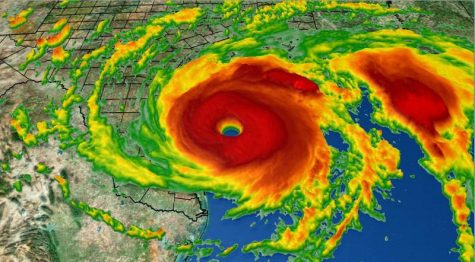The Climate Calamity Causing Hurricane Havoc
As the temperature of Earth’s climate continues to climb, so does the severity and destructive potential of hurricanes.
Junior Megan Oberuch has noticed the destruction recent hurricanes have caused to towns and cities, commenting, “Growing up I feel I always heard of lower strength hurricanes, but as time has gone on there have been more and more higher strength hurricanes.”
This amplification of the destructive potential of hurricanes leads to a greater danger to human life and property, especially in coastal areas of the U.S. An increase in storm surge by several feet can easily allow for a hurricane to advance to a higher category on the Saffir-Simpson scale, a ranking system used to categorize hurricanes based on their wind speed and storm surge.
The torrential rainfall of hurricanes is expected to rise along with storm surge, which contributes to severe coastal flooding. Unfortunately, the intensification of hurricane storm surge and precipitation correlates with the construction of houses/businesses in coastal areas of the U.S. The combination of these two factors maximizes the amount of people put in danger.
Due to this growth in hurricane severity, Sophomore Natalie Jeon remarks, “I do think that stronger hurricanes are a concern, especially because it seems like extreme weather occurrences are still increasing, and we haven’t reached a peak yet. Every year, especially during the summer, new records for either hurricanes or tornadoes or heat are being made.”
The increase in atmosphere and sea surface temperatures specifically leads to greater precipitation totals and higher wind speeds, two qualities of a strong hurricane.
Warmer atmospheric temperatures and additional moisture allows for a greater amount of water vapor to collect. This water vapor is then converted into the precipitation of hurricanes. Warmer sea surface temperatures promote higher amounts of rainfall during hurricanes, as they provide hurricanes with more heat energy during development. These factors were some of the defining characteristics of a well-known hurricane that hit the U.S., Hurricane Harvey.
Hurricane Harvey, a category four hurricane that hit the U.S. in 2017, is a storm popularly known for its unprecedented amounts of rainfall. In a meta-analysis comparing four studies regarding the connection between climate change and Hurricane Harvey’s precipitation, results indicated that although there were other factors, such as natural climate processes that contributed to Hurricane Harvey’s extreme precipitation, human-sourced climate change did play a role.

In addition to hurricane precipitation, could the wind speed of hurricanes be enhanced by warmer sea surface temperatures in a similar fashion?
Dr. Allison Wing, assistant professor from the Earth, Ocean, and Atmospheric Science department at Florida State University, explains, “We understand from basic physics that the maximum possible intensity a hurricane can reach (a ‘speed limit’ for hurricane winds) increases with warmer sea surface temperatures. This is because hurricanes get their energy from fluxes of heat from the sea surface to the atmosphere. A warmer climate provides greater fuel for hurricanes.”
Junior Samantha Tu agrees that there “is a link between hurricane strength and human influence on the environment.[…] When you have warmer weather the climate becomes perfect for hurricanes to develop. The warmer the temperature is, the more power hurricanes are able to draw from, which increases the life of the hurricane and then more devastation caused by them.”
As Tu stated, some of the ingredients hurricanes require to gain strength include atmospheric moisture and warm atmosphere/sea surface temperatures.
The growing amount of greenhouse gases, such as carbon dioxide, entering the atmosphere leads to the warming of the ocean and atmosphere along with the collection of moisture. Ultimately, this creates the perfect conditions for hurricane wind speed and precipitation to escalate. Consequently, atmospheric and oceanic warming prompts the melting of polar ice, which contributes to the rise in sea levels and hurricane storm surge.
Over the years, hurricanes have become more and more powerful. This upward trend is expected to continue, and combined with a warming climate, the menacing threat of devastation still persists.

![Photo Courtesy of
A teen faces colorism at school and at home in 'Genesis Begins Again'
[Photograph]. (n.d.). NPR.https://www.npr.org/2019/01/31/690381040/a-teen-faces-colorism-at-school-and-at-home-in-genesis-begins-again
A complex-ion issue: Colorism [Photograph]. (n.d.). The Chronicle. https://hwchronicle.com/55860/features/a-complex-ion-issue-colorism/
The colorism issue [Photograph]. (n.d.). Issuu. https://issuu.com/overachievermagazine/docs/colourism
_issue_om](https://lrhslightningflash.com/wp-content/uploads/2021/06/Colorism-is-alive-475x380.jpg)
![Long Reach Boosters Club. (March 24, 2023 - 11:33pm). [Digital Image]. Long Reach Has Talent Show Spring 2023. Facebook, Retrieved April 17, 2023 from https://www.facebook.com/longreachboosters/posts/pfbid03kN5BKQj5TDefz1rtVZ5fTBBhjwA39UPPd8GctyMgFvY7B4RihH4rY4EqE7xPwikl.](https://lrhslightningflash.com/wp-content/uploads/2023/05/LR-Talent-Show-3-475x316.jpg)

